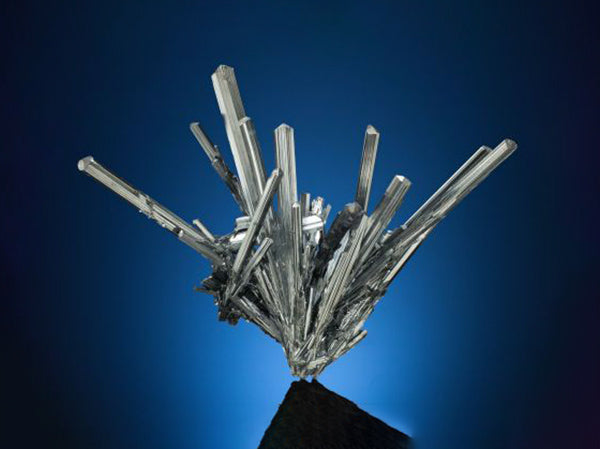
There are many reports on antimony-based alloy materials. In addition to SnSb, the main alloy forms are InSb, Cu2Sb, MnSb, Ag3Sb, Zn4Sb3, CoSb3, NiSb2, CoFe3Sb12, TiSb2, VSb2, etc.
Someone systematically studied InSb, Cu2Sb, MnSb antimony-based alloy materials. Insb has a zinc blende structure (cubic ZnS crystal type), a face-centered cubic lattice is formed by antimony atoms, and indium atoms are distributed in the interstices of its tetrahedrons. When lithium is inserted into InSb, along with the extraction of indium, lithium gradually occupies the gap position of the zinc blende, most of which is Li3Sb and indium. The volume expansion of the antimony lattice in the whole reaction is only 4.4%, and if the extracted indium is taken into account, the volume expansion is only 46.5%.
Studies have found that the released indium will gradually agglomerate and grow to produce indium whiskers, which limits the combination of indium and antimony in the subsequent charging process. In the 1.2~0.6V cycle, the reversible capacity of InSb reaches 250~300mA·h/g. When the discharge voltage is lower than 0.55V, the cycle performance of InSb is very poor, because indium and lithium form an InLix alloy. Cu2Sb has a tetragonal structure, and copper and antimony atoms are arranged in layers, sandwiched between copper atoms.
The mechanism of Cu2Sb lithium insertion is similar to that of Cu6Sn5. First, a copper atom is removed to generate metastable Li2CuSb with a zinc blende structure, and lithium is further inserted to generate Li3Sb and copper. When charging and discharging at 1.2~0V, the reversible capacity of Cu2Sb is 290mA·h/g, the volume capacity is 1914mA·h/g (density 6.6g/cm3), the charge-discharge efficiency is ≥99.8%, and the first irreversible capacity loss is 30%. The excellent recycling energy of Cu2Sb is that the released copper is highly dispersed in the grain boundaries and the growth of copper grains is slow. MnSb has a NiAs structure, and its lithium insertion mechanism is similar to Cu6Sn5. LiMnSb is formed first, then Li3Sb, 1.5 ~0V charge and discharge, the reversible capacity is 300mA·h/g, but due to the slow diffusion rate of manganese, the electrochemical reaction rate is limited.
Someone uses vacuum high-temperature smelting and annealing after ball milling to prepare alloy materials such as Zn4Sb3 and CoSb3. Studies have found that zinc precipitates from Zn4Sb3 during ball milling and combines with oxygen to form ZnO, so the zinc content in the alloy decreases to form ZnSb.
In the process of lithium insertion, lithium first replaces part of the zinc in the zinc oxide to form a support with a network structure in which ZnSb is dispersed to form an active phase for lithium insertion, and uses its own structure of tetrahedral or octahedral gaps Charge and discharge lithium. When charged and discharged between 2.5V and 0.005V, the first discharge capacity of Zn4Sb3 is 566mA·h/g, but the cycle performance is very poor. After ball milling with graphite, the cycle performance is improved. The reversible capacity for 10 cycles is 400mA·h/g. g above. The lithium insertion mechanism of CoSb3 is different from that of Zn4Sb3. CoSb3 is decomposed to form active component antimony and inactive component cobalt during the first lithium insertion process. The decomposed antimony plays a role of reversible lithium storage, while cobalt plays a role in dispersing active materials and It prevents the shop from gathering in the circulation process.
The study also found that as the size of the CoSb3 particles decreases, the reversible capacity increases in turn. The reason is that after the particle size decreases, the diffusion path of lithium ions inside the electrode powder particles becomes shorter, which reduces the local charge accumulation on the electrode surface during charging and discharging. , So that more active materials participate in the electrochemical reaction process.